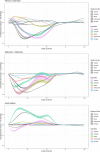A three-dimensional musculoskeletal model of the dog
- PMID: 34059703
- PMCID: PMC8166944
- DOI: 10.1038/s41598-021-90058-0
A three-dimensional musculoskeletal model of the dog
Abstract
The domestic dog is interesting to investigate because of the wide range of body size, body mass, and physique in the many breeds. In the last several years, the number of clinical and biomechanical studies on dog locomotion has increased. However, the relationship between body structure and joint load during locomotion, as well as between joint load and degenerative diseases of the locomotor system (e.g. dysplasia), are not sufficiently understood. Collecting this data through in vivo measurements/records of joint forces and loads on deep/small muscles is complex, invasive, and sometimes unethical. The use of detailed musculoskeletal models may help fill the knowledge gap. We describe here the methods we used to create a detailed musculoskeletal model with 84 degrees of freedom and 134 muscles. Our model has three key-features: three-dimensionality, scalability, and modularity. We tested the validity of the model by identifying forelimb muscle synergies of a walking Beagle. We used inverse dynamics and static optimization to estimate muscle activations based on experimental data. We identified three muscle synergy groups by using hierarchical clustering. The activation patterns predicted from the model exhibit good agreement with experimental data for most of the forelimb muscles. We expect that our model will speed up the analysis of how body size, physique, agility, and disease influence neuronal control and joint loading in dog locomotion.
Conflict of interest statement
The authors declare no competing interests.
Figures







References
Publication types
LinkOut - more resources
Full Text Sources
Miscellaneous

